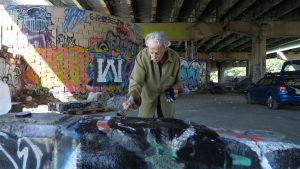Robert Janz’s Disappearing Acts
Description
Leaving a mark on the world implies permanence. For Robert Janz, it is more fleeting, like life itself.
Featured Artists

Robert Janz is a celebrated artist known for his impermanent artworks in the streets of New York City.
Janz was born in 1932 in Belfast, Northern Ireland, and emigrated to the United States with his parents. He moved to Los Angeles in the 1960s and began drawing in the sand on Venice Beach, letting the waves erase his efforts. “Six Sticks,” his changing arrangement of white pine inspired by the hexagram arrangement important in the Chinese philosophical text I Ching, was exhibited in L.A. and New York in the mid-1970s.
Although he does paint and sell artwork, much of Janz’s work is inspired by the Buddhist principle of transience. He has lived in New York since the 1970s, creating ephemeral artwork mostly in his Tribeca neighborhood of Manhattan. His drawings with water disappear as they dry, his paintings on posters and walls in the city are meant to be erased or covered, his rearrangements of chairs in the courtyard of the Irish Cultural Center in Paris were intended to be short-lived.
He was the subject of the 2020 documentary JANZ: In the Moment by filmmaker Joanna Kiernan.
Transcript
Walk around the streets of Manhattan’s Tribeca neighborhood over morning, and you’ll likely find a curious figure out and about making his daily, very transitory contributions to the New York art scene.
Robert Janz: Everything is transient. Everything passes.
Robert Janz, now in his 80s, has been making art that puts viewers toe to toe with his outlook on the world since the 1960s. He arrived on the L.A. art scene with his 1973 series called Six Sticks, a reference to an important number in the ancient Chinese text, the I Ching.
As a teenager, Janz had fallen in with a hip crowd of Eastern philosophy buffs and he quickly took to their Zen ideas. Today, all of his work is an exercise in transience, the Buddhist principle that everything changes. In fact, he’s taken the idea so deeply to heart that, without photography, hardly anyone would know about his work. Whether drawing with water, creating patterns with chairs in a public square, or reclaiming space with washable paint, Janz’s works are most often designed to disappear—or, at best, transform before the viewer’s eyes.
Jennifer Kotter: Robert works continuously and just produces, produces, produces work. And thousands of pieces come out of him and he destroys half of them. And then he keeps going, and it’s just a never-ending process. He doesn’t leave much behind as evidence because he loves this aspect of impermanence, and he’s really very much tuned in to that.
AJC: People these days talk so much about what they’re going to leave behind them. That doesn’t interest you at all.
Janz: Things get left behind anyway, and you don’t have to strive for it. And what’s left behind is usually quite different than the person who initiated it thought. You know, Einstein thought he was leaving a legacy by discovering the atom but he left a bomb, instead. People are always talking about what they’re going to leave behind and it so often turns out to be quite different in its result than they thought. So it’s better not to press that button too hard. It’s as likely that what I do with water, that goes in a couple of minutes, is as likely to influence the future—put something into the future that is worth holding on to—as some gigantic piece of bronze.
And though Robert Janz has been called a performance artist, a street artist, and a conceptual artist, he’s quick to defend his own independence from such labels.
Janz: All my life, I’ve resisted categories. I resist the idea of the word “artist,” and “street artist” in particular. I’m not a street artist. I do a lot of drawing in the street, but it’s for reasons that have to do with freshness and the rawness.
AJC: What drives you to be this way? ‘Cause there’s definitely a rebellious streak to you.
Janz: I don’t think of myself as a rebel, as simply following what art says. All art says, “Open your eyes. Throw off the blinkers of clichés. Step outside the box. Open yourself to the world. Pay attention.” But people close down the message of art by talking about names and prices and putting it in a special category. My view of art is that it is soul medicine, and it should explore in every possible way. So I do drawings that evaporate in five minutes. I do other things that stay up for a couple of weeks. I do paintings. I write poems that also, themselves, are objects.
“We’re What We Witness” is an object poem. It isn’t a musical poem like, “Shall I compare thee to a summer day?” It’s in a block form, and it alliterates for specific reasons so that it’s a construction. But it tells the truth. We are what we witness, and I think we should go out into the world and witness it, and engage it, and respect it.
We’re what we witness.
We witness our will at work in the world.
We witness our will at work in the world
Working our world
Wanting our world
Wrecking our world
Wasting our world
Worrying our world.
We witness whether we will or will not.
We witness.
We’re what we witness.

